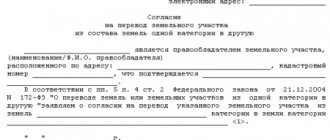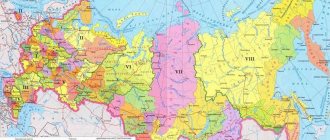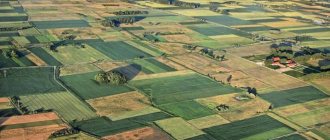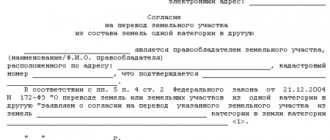All territories in the Russian Federation are divided into sections depending on their composition. Regardless of who owns the land, land plots are necessarily assigned a category - a legal regime that establishes acceptable ways of using real estate.
The owner (land user) does not have the right to change the category independently - a strictly regulated procedure for transfer and registration allows to avoid abuses during the operation of the site.
Citizens most often face the need to transfer a plot from one category to another when it comes to small plots of land received many years ago for use from the municipality or a horticultural non-profit partnership (hereinafter referred to as SNT). Even registration of ownership or privatization of such land does not give the owner the official right to build and register on this territory a residential building or other object that does not meet the target requirements. To register a building with the state, it is necessary to obtain permission to transfer land from one category to another.
Categories of land in Russia
The Land Code (hereinafter referred to as the Land Code of the Russian Federation) divides land into the following categories:
- Industrial. Plots in this category are allocated for the construction of transport routes and buildings, buildings for the defense and security of the country, for energy, communications and scientific programs buildings and other special purposes.
- Lands of populated areas (hereinafter referred to as ZNP). Plots allocated for the development of residential properties. The main feature of such lands is that they cannot be located on land territories for other purposes or in private ownership.
- Agricultural purposes (hereinafter referred to as Agricultural Purposes). Land resource necessary for the production of agricultural products: pastures, arable lands, plots for gardening and horticulture, forest shelterbelts, reservoirs for growing fish and lands of similar properties.
- Water fund.
- Specially protected. These include territories that are withdrawn (partially withdrawn) from general circulation and are of valuable importance.
- Forest fund (read: how to get forest for free from the state).
- Reserve lands. State plots that have not been transferred for use to citizens or organizations and have not been sold into ownership.
Why are developers interested in agricultural land?
Russian citizens want (at least those who can afford it) to own country houses built on their own plots of land, so that on weekends and during vacations they can relax there from the polluted air, noise and bustle of big cities, and many are not averse to constantly live them.
In the last decade, like mushrooms after rain, elite cottage villages have been growing around large industrial centers, which were built on former agricultural land, and the developers first had to transfer the agricultural land to another category. As a rule, this is the territory of populated areas, allowing residential development.
From their point of view, this is quite logical. What kind of land should we build on? After all, the share of land in settlements in the total land fund of Russia is only about 1%, and the possibilities of using them for construction are practically exhausted. So developers turn their keen eye to the vast Russian fields, biting off more and more pieces from them, initiating the transfer of agricultural plots to another category.
Transferring a site from one category to another: what you need to know
Changing the purpose of a land plot today is regulated by the provisions of the Land Code of the Russian Federation and Federal Law No. 172-FZ dated December 21, 2004 (current edition dated July 29, 2017, hereinafter referred to as Federal Law 172). Before starting the procedure for transferring the category of land plot to another legal status, the owner (user) will need to clarify whether the legislation can allow such changes. The provisions of Federal Law 172 establish restrictions and mandatory conditions that must be observed to change the category of a particular type of land:
- For ZSHN. The transfer of such valuable plots for the state on a general basis is prohibited (clause 2 of article 7 of Federal Law 172). Exceptional circumstances allowing changes are provided for plots whose value is lower than 50% of the average cadastral price of land in the region. The law includes the following reasons for changing the category as such conditions:
- conservation of the territory;
- creation of especially valuable zones;
- expansion of the ZNP;
- planned construction of industrial structures;
- transfer to the water or forest fund, to land reserve zones, if the territory of the agricultural reserve has become unsuitable for exploitation;
- construction of roads, power lines, pipelines;
- for defense needs, implementation of international government projects;
- planned development of mineral resources on site;
- placement of social facilities, including for education and healthcare, if there is no other territory for the construction of this facility.
You may be wondering how to rent agricultural land.
- RFP. It changes along with the expansion (decrease) of the limits of the settlement (Article 8 of Federal Law 172).
- Industrial zones can be transferred to other categories without special restrictions (Article 9 of Federal Law 172), but subject to complete restoration according to a reclamation plan.
- Lands with a special status (protected, valuable). They are transferred to another category extremely rarely due to the loss of valuable properties (Article 10 of Federal Law 172). Conversely, any territory, with the exception of the ZNP, can receive the status of a specially protected zone, if there are conditions for creating a tourist, environmental or other similarly valuable zone in this area.
- Forest and water areas. They are transferred when creating particularly valuable areas or constructing an object of state (municipal) importance, and are also integrated into the expanding boundaries of the settlement (Articles 11, 12 of Federal Law 172).
It should be clarified that restrictions on the transfer of a specific territory to another category may be imposed by special regulations. You can find out for sure whether the transfer procedure can be carried out for a specific plot by sending a request in advance to the land and property department of the municipality in whose department this land is located.
Agricultural land (according to the Land Code of the Russian Federation)
According to the Land Code of the Russian Federation, such plots are always located outside the boundaries of populated areas and are provided and also intended for agriculture.
As mentioned above, slightly less than half the area of all agricultural land is occupied by farmland - these are arable lands, meadows for haymaking, pastures, gardens, vegetable gardens, vineyards, etc. This also includes hunting farms.
The second half of the total area of all agricultural plots (or a little more than half) is located under roads running inside agricultural enterprises, various utilities, forest belts, ponds for reclamation and fish farming, as well as various outbuildings.
Obviously, developers are of little interest in the half of agricultural land that does not belong to land - after all, these territories have already been built up with something or are occupied by some kind of linear structures. For residential development, practically the only possible way is to transfer plots from agricultural land to another category.
The process of changing the category of land: step-by-step instructions
The owner of the plot or land user has the right to initiate the transfer procedure, which can be citizens, representatives of a legal entity (LE), individual entrepreneurs (IE) or communities of small indigenous peoples of Russia, and in some cases - the competent bodies of state (municipal) authorities. Step-by-step instructions for changing the category of land are as follows (Article 3 of Federal Law 172):
Step 1. Preparing a package of documents
A complete list of documentation is contained in Article 2 of Federal Law 172:
- Passport or other identification document of the applicant.
- An extract confirming the registration of an individual entrepreneur or legal entity (if necessary).
- Extract from the Unified State Register of Real Estate. If the owner (user) does not have a paper copy with a seal, a request for receipt will be sent by the executive authorities.
- Documents confirming the acquisition of ownership of land (sale and purchase agreement, certificate of inheritance, etc.) or consent from the owner if the site is operated under the right of use.
- Conclusion of the environmental assessment.
The latter document is not required for every category of real estate, but under the conditions determined by federal laws.
In addition to the above, additional documents may be requested from the applicant in accordance with federal (municipal) regulations and decrees of the Government of the Russian Federation (clause 2 of article 2 of Federal Law 172).
Step 2. Submit an application (petition)
Depending on the ownership of the plot of land, the application should be submitted to the land and property department of the regional government or local government.
The document is drawn up in free form or on a form approved by the competent authorities. A sample of filling out an application can be found on information stands or on the website of the department that accepts such applications. When compiling, you must indicate:
- cadastral number of the claimed plot;
- the applicant's rights to land;
- the current category of allotment and the category of the planned transfer;
- justify the reason for transfer to this category.
Step 3. Making a decision and drawing up the corresponding act
An accepted application is considered within 2 months (by city and municipal authorities) or 3 months (by the regional government or the Government of the Russian Federation). Notification of transfer (refusal to transfer) of a land plot to another category is sent to the applicant within 2 weeks from the date of the decision.
If the result is positive, the land and property department draws up an act on transferring the land to the declared category. There is no need to re-register other land documentation.
Step 4: Register a category change
A copy of the act is sent from the local (regional) administration to the territorial department of the Federal Service for State Registration, Cadastre and Cartography (Rosreestr department) within ten days from the date of approval of the decision. Changes are made to the Unified State Register on the basis of this act (Article 5 of Federal Law 172).
The service of notifying Rosreestr about a change of category is provided to the applicant free of charge. For the provision of government services for making changes to the Unified State Register of Real Estate, the owner (user) of the site will need to pay a state fee in the amount of 350 rubles. (Article 333.33 of the Tax Code of the Russian Federation).
After registration, the owner of the plot can begin to use the plot in accordance with the new legal status of the land.
Additional documents for translation
Additionally you will need:
- an extract from the state cadastre for the site or its cadastral passport;
- copies of the applicant’s personal documents;
- extract from the Unified State Register;
- conclusion of state environmental examination (if necessary);
- consent of the copyright holder if the land user applies.
Copies of personal documents and the consent of the copyright holder are submitted by the applicant to the authorized government body along with the petition. It is not necessary to submit the remaining documents, since the authorized government agency can request them independently. However, to speed up the procedure, it is better to take care of their availability and provide it yourself.
Refusal to change the category of land
The applicant may be refused at the stage of submitting the application. Reasons for this may be that the person does not have the right to submit a petition, as well as incorrect or incomplete execution of the required attached documents. To re-apply, you must eliminate all the shortcomings indicated in the refusal documents.
An official refusal to transfer a plot of land to another category is made on the grounds listed in Art. 4 Federal Law 172:
- restriction (prohibition) on transfer to another category imposed by current legislation;
- the declared category contradicts the intended purpose of the allotment;
- The environmental state examination has identified the negative consequences of the upcoming transfer.
Another reason why a transfer cannot be made is if the cadastral value of the declared territory is too high (more than 50% relative to the average value for the region). In any of these cases, the applicant will be returned the full package of documents within 30 working days from the date of submission of the application, notifying him of the reason for the refusal.
The applicant can challenge the decision through the court and, if the court decides positively, send a new petition. The appeal procedure is as follows:
- Obtain the act from the property and land department.
- Draw up and submit a statement of claim to declare the drafted act illegal. Attach documents to the application:
- a photocopy of the issued act;
- a copy of the application and accompanying documents;
- documentation confirming the illegitimacy of the refusal or permission to transfer;
- receipt of payment of state duty;
- other documents related to the trial.
- Having received notice of the place and date of the hearing, appear in court at the appointed time.
- If the court satisfied the requirements of the statement of claim, obtain a copy of the court decision from the office.
- Submit a second petition, attaching the court decision to the package of documents.
Transfer to settlement lands
As mentioned above, agricultural plots can be included in populated areas and assigned to them another category - “land of populated areas.” Once inside their borders, they find themselves within a specific territorial zone, which is subject to urban planning regulations, including the establishment of VRI, which provide for their development. The procedure for such inclusion with the simultaneous establishment (or change) of VRI can be carried out in accordance with Art. 41 Federal Law “On the entry into force of the Civil Code of the Russian Federation”.
The appeal process using an example from judicial practice
The owner of a dacha plot, citizen P., filed a statement of claim in court with a request to declare illegal the act of refusal to transfer the plot from agricultural land to the ZNM category. Citizen P. justified his claim by the fact that in connection with the expansion of the residential microdistrict planned for 2021 - 2019, the decision of the meeting of the district Duma of the Starodvorsky municipal district No. 321-r approved the master plan for the urban settlement of Veseloe, Starodvorsky district, according to which his dacha was included within the city limits n. Merry.
On July 1, 2021, citizen P. sent a petition to the administration of the Starodvorsky district to include his plot in the territory of the Veseloye settlement and transfer the dacha land from the ZSHN category to ZNP for individual housing construction (IZHS).
The administration of the Starodvorsky district made a decision to refuse to include the site within the boundaries of the Veseloye settlement due to the fact that construction of a residential complex has not yet begun, due to which the boundaries of the village are expanding.
Having considered the presented materials, the court came to the conclusion that the act of refusal issued in response to the petition of citizen P. was unfounded. In accordance with paragraph 1 of Article 7 of Federal Law 172, the expansion of the territory of an urban settlement, fixed by urban planning, is a legitimate reason for the transfer of dacha ZSHN to the declared category of ZNP
On the basis of this, the court made a decision to invalidate the act of the administration of the Starodvorsky district, and also recognized citizen P.’s right to include the land belonging to him in the town of Veseloye, Starodvorsky district, and the right to transfer the declared allotment from the ZSKHN category to the ZNP.
Types of permitted use of farmland
What opportunities does Russian legislation provide for performing this procedure? The Land Code of the Russian Federation states that the legal regime of any land is determined by its two main characteristics:
- belonging to one category or another;
- permitted use, which is established during zoning of territories.
This is where the first snag lies. While there can be no doubt about whether farmland belongs to the category of agricultural land (category 1 under the Land Code of the Russian Federation), there is no complete clarity regarding its permitted use.
Indeed, today the only type of territorial surveying actually carried out in the Russian Federation is urban planning zoning. It is not carried out for farmland, and the VRI of plots from their composition is not established.
True, according to some experts in the field of land legislation, the list of types of their use given in Article 78 of the Land Code of the Russian Federation can be accepted as the VRI of farmland plots. In addition, Federal Law No. 101 “On the turnover of agricultural land” distinguishes from its composition areas the legal regime of which is regulated exclusively by the Land Code of the Russian Federation, and intended for the following purposes:
- for individual housing construction;
- for garages;
- for LPS;
- for dachas;
- for gardens and vegetable gardens;
- for pasture;
- for various outbuildings.
So, the Town Planning Code (GrK RF) allows the inclusion of both farmland and dacha and garden areas in settlements. And this just means transferring agricultural land to another category.
Request for transfer
A petition to change the category of land is a kind of application to the authorities. The exact form of the application for each subject of the Russian Federation is approved by local authorities. According to paragraph 3 of Art. 2 Federal Law No. 172, the following information must be indicated in the application:
- Full name, address and passport details of the applicant;
- Unified State Register of Legal Entities certificate number - for organizations;
- Cadastral number and address of the site;
- Current and preferred land categories;
- Reasons for changing category;
- Type of right to the site;
- Data on the area and purpose of the land;
- Information about the decision of the environmental commission.
Filling out the title page should begin with the name of the circulation authority. The main part sets out the request to change the category of land, indicating the reasons.
The reasons are first stated as the absence of legal obstacles to the transfer and supported by relevant data (for example, a comparison of the cadastral value of the plot with the average for the region). Then they give reasons for changing the category of land (the need to build a house or a factory) and indicate why construction in another part of the region is inappropriate (great distance from the center, disruption of the ecosystem, etc.).
At the end of the application there is a list of the attached documents and the signature of the applicant.
You can find out how to get maternity benefits by reading our thematic material. Sick leave payments do not always go smoothly. You can find out how to arrange them correctly here!
How to correctly make entries in employee salaries - read our article.
Change of land category
Changing the category of a land plot implies the adoption of a corresponding resolution by the authorities with a subsequent change in the type of permitted use of such a plot. The procedure for changing land categories is regulated by:
- Art. 8 of the Land Code;
- Law No. 172 “On the transfer of land... from one category to another.”
In Art. 8 of the Land Code states that a change in the category of agricultural land can be carried out by decision of the Government of the Russian Federation or regional executive power.
The government makes decisions on state agricultural lands demarcated in favor of federal property, and the authorities of the constituent entities of the Russian Federation - on areas belonging to regional and municipal lands.
Withdrawal of an allotment from the status of agricultural storage: procedure
Transferring agricultural land to individual housing construction is a complex and lengthy procedure. The owner of the site must submit a corresponding petition to the local authorities. Only the owner of the land has this right. If we are talking about a plot that is in shared ownership, each of the co-owners can contact the municipality. An application in the prescribed form is submitted. It should contain information about:
- cadastral number of the plot;
- purpose;
- categories where the owner wishes to transfer the land;
- reasons for changing status;
- right of ownership.
The cadastral number is indicated in the corresponding passport. If it is not there, you need to contact the representative office of the Federal Service for State Registration, Cadastre and Cartography. This organization keeps records of sites located in the region. To receive the service you must pay a state fee.
The further procedure involves coordination of boundaries, land surveying and drawing up a boundary plan.
After considering the application, local authorities make a decision. If it is positive, the applicant is issued a certificate of transfer of the site from the category of agricultural agricultural use. In case of refusal, the owner is given a document indicating the grounds for making a negative decision.










